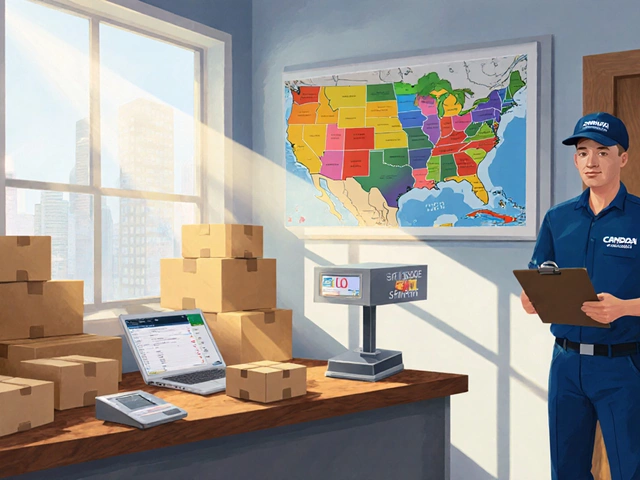USPS vs UPS International Shipping Calculator
Compare Your Shipment
Calculate exact shipping costs for USPS and UPS based on your package details and destination.
When you need to send a package overseas, the first question that pops up is cost: cheapest international shipping often decides whether you pick USPS or UPS. Both carriers promise speed and reliability, but their pricing structures differ dramatically based on weight, size, destination, and added services. This guide breaks down exactly how each carrier calculates fees, highlights hidden cost drivers, and gives you a step‑by‑step way to figure out which option saves you money for any given shipment.
Understanding USPS International Shipping
USPS is the United States Postal Service, a government‑run carrier that handles both domestic and cross‑border parcels. USPS International Shipping covers a suite of services like First‑Class Package International, Priority Mail International, and Priority Mail Express International. The pricing model is relatively straightforward: you start with a base rate tied to the service tier, then add fees for weight, dimensional weight, and destination zone.
- Base rates: Each service has a flat price for the first ounce (or first kilogram for some tiers). For instance, Priority Mail International starts at $35.50 for a 1‑lb package to most countries.
- Weight charges: After the initial allowance, USPS adds a per‑ounce (or per‑kg) surcharge. Because the U.S. uses a mixed system, you’ll often see prices rounded up to the nearest ounce.
- Dimensional weight: If your package is bulky relative to its weight, USPS applies a dimensional weight factor (usually 139in³ per lb for international parcels). The carrier charges the greater of actual weight or dimensional weight.
- Destination zones: USPS splits the world into zones (A, B, C, etc.) based on distance and bilateral agreements. Zones affect both base rates and surcharges.
- Optional services: You can add insurance, signature confirmation, or customs form filing for extra fees.
USPS also offers a free online Rate Calculator that lets you plug in weight, dimensions, and destination to see an instant quote.
How UPS Calculates International Rates
UPS is United Parcel Service, a private logistics giant with a global network. UPS International Shipping includes services such as UPS Worldwide Expedited, UPS Worldwide Saver, and UPS Standard. UPS’s pricing is more granular than USPS and leans heavily on a commercial‑rate structure.
- Base rates: Each service tier starts with a minimum charge that varies by origin-destination pair. For example, UPS Worldwide Expedited might start at $45 for a 0.5‑kg parcel to Europe.
- Weight and dimensional weight: UPS uses a dimensional factor of 139in³ per lb for most international shipments, similar to USPS, but the calculation is done automatically in their system. The higher of actual weight or dimensional weight is billed.
- Shipping zones: UPS maps the world into numbered zones (1‑10). Zones are determined by distance and the carrier’s negotiated agreements with local partners, influencing both base and per‑kg rates.
- Fuel surcharge: UPS adds a variable fuel surcharge (typically 12‑15% of the base rate) that updates monthly based on global fuel price indexes.
- Customs brokerage and duties: UPS can act as a customs broker for a fee, handling paperwork and clearance on your behalf.
- Optional services: Insurance, declared value, Saturday delivery, and signature on delivery are available at extra cost.
UPS provides an online Shipping Calculator that incorporates all these variables to give a final price before checkout.
Key Cost Drivers Common to Both Carriers
Even though USPS and UPS have different pricing philosophies, several factors influence the final bill for any international shipment:
- Weight vs. size: A heavy but compact box may be cheaper than a light, boxy one because dimensional weight can double the cost.
- Destination country: Some nations are in higher‑cost zones due to limited carrier partnerships, security fees, or remote‑area surcharges.
- Customs duties and taxes: These are not part of the carrier’s fee but affect the total amount the recipient pays. UPS often offers DDP (Delivered Duty Paid) options that bundle these costs.
- Fuel surcharge: While USPS applies a modest fuel surcharge, UPS’s can be significantly higher, especially when oil prices spike.
- Additional services: Insurance, signature, declared value, and Saturday delivery add fixed or percentage‑based fees.
Quick Cost Comparison: Real‑World Scenarios
Below is a side‑by‑side look at how a 2kg (4.4lb) package priced for three popular destinations stacks up. All packages are 30cm×20cm×10cm, which stays below the dimensional weight threshold for both carriers.
| Carrier | Service | Base Rate (USD) | Fuel/Additional Surcharges | Total Before Optional Fees | Typical Delivery Time |
|---|---|---|---|---|---|
| USPS | Priority Mail International | $42.00 | $3.00 (fuel) | $45.00 | 6‑10 business days |
| UPS | Worldwide Expedited | $48.00 | $7.20 (15% fuel) | $55.20 | 4‑7 business days |
| USPS | Priority Mail Express International | $55.00 | $4.50 (fuel) | $59.50 | 3‑5 business days |
| UPS | Worldwide Saver | $58.00 | $8.70 (15% fuel) | $66.70 | 2‑4 business days |
From the table you can see that USPS usually wins on price for standard delivery, while UPS offers faster transit at a premium. If speed isn’t critical, USPS is often the clear winner for low‑to‑moderate weight parcels.
Decision Checklist: When to Choose USPS vs. UPS
- Budget‑first shipments: Choose USPS if you’re under $60 and can tolerate a 6‑10‑day window.
- Time‑sensitive orders: Opt for UPS Worldwide Saver or Expedited when you need 2‑5‑day delivery.
- Large or heavy items: UPS’s higher weight brackets (up to 150lb) and better handling of oversized parcels can make it cheaper than USPS, which caps at 70lb for most international services.
- Customs brokerage needs: UPS can act as a broker, simplifying paperwork for high‑value goods.
- Package tracking depth: UPS provides end‑to‑end tracking with location updates every few hours; USPS tracking is reliable but less granular for some remote destinations.
- Insurance requirements: UPS includes higher default liability limits (up to $100) versus USPS’s $50 limit, reducing the need for extra insurance.

Tips to Trim International Shipping Costs
- Measure twice, ship once: Use a box that’s just big enough. Reducing empty space can lower dimensional weight.
- Flatten the package: Flat envelopes for documents often qualify for lower First‑Class rates with USPS.
- Consolidate orders: Shipping several items together avoids multiple base fees.
- Leverage flat‑rate boxes: USPS Priority Mail International flat‑rate boxes can be cheaper for heavy items up to 4kg.
- Negotiate volume discounts: If you ship >100 parcels a month, both USPS (via Commercial Base Pricing) and UPS offer negotiated rates.
- Pre‑pay customs duties: Using DDP with UPS can prevent surprise fees for the recipient and sometimes secures a lower overall rate.
- Use online calculators: Both carriers’ APIs let you batch‑process quotes, ensuring you always pick the lowest price before labeling.
Frequently Asked Questions
Frequently Asked Questions
Which carrier is cheaper for a 5kg parcel to Europe?
For a 5kg (about 11lb) box, USPS Priority Mail International usually costs around $85‑$95, while UPS Worldwide Expedited ranges from $110‑$125 after fuel surcharges. Unless you need faster delivery, USPS wins on price.
Does UPS charge for customs brokerage?
Yes. UPS adds a brokerage fee (often $15‑$30) plus any duties and taxes. If you opt for their DDP service, the fee is bundled and disclosed upfront.
Can I get a discount on USPS international rates?
Businesses can enroll in USPS Commercial Base Pricing, which trims the per‑ounce charge by about 10‑15% compared to retail rates. You need a USPS business account to qualify.
How does dimensional weight affect my shipping cost?
Both carriers compare actual weight with dimensional weight (calculated as length×width×height÷139 for international parcels). If the dimensional weight is higher, you’re billed for that value, which can jump the price dramatically for lightweight but bulky items.
Is tracking reliable for both carriers?
UPS offers real‑time, step‑by‑step tracking that updates at each hub. USPS provides tracking for most international services, but updates can be slower or missing for remote destinations. For high‑value items, UPS’s richer data is a plus.
Bottom line: if you’re chasing the cheapest rate and can wait a week or two, USPS is the go‑to for most small‑to‑medium parcels. If speed, higher weight limits, or full customs handling matter more, UPS justifies the extra cost. Use the calculators, check dimensional weight, and run a quick quote for both carriers before you print that label.





